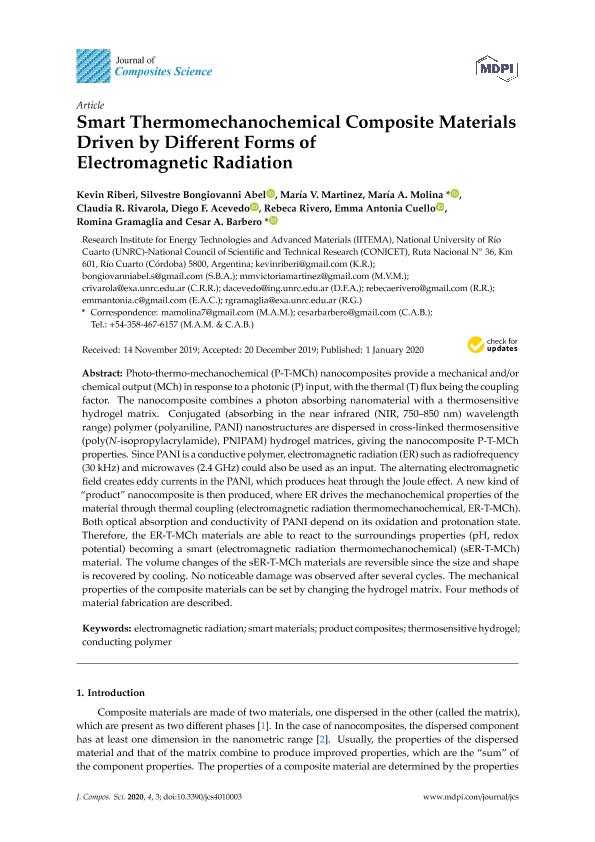Artículo
Smart thermomechanochemical composite materials driven by different forms of electromagnetic radiation
Riberi, Kevin Sebastián ; Bongiovanni Abel, Silvestre Manuel
; Bongiovanni Abel, Silvestre Manuel ; Martinez, María Victoria
; Martinez, María Victoria ; Molina, María Alejandra
; Molina, María Alejandra ; Rivarola, Claudia Rosana
; Rivarola, Claudia Rosana ; Acevedo, Diego Fernando
; Acevedo, Diego Fernando ; Rivero, Rebeca Edith
; Rivero, Rebeca Edith ; Cuello, Emma Antonia
; Cuello, Emma Antonia ; Gramaglia, Romina Andrea
; Gramaglia, Romina Andrea ; Barbero, César Alfredo
; Barbero, César Alfredo
 ; Bongiovanni Abel, Silvestre Manuel
; Bongiovanni Abel, Silvestre Manuel ; Martinez, María Victoria
; Martinez, María Victoria ; Molina, María Alejandra
; Molina, María Alejandra ; Rivarola, Claudia Rosana
; Rivarola, Claudia Rosana ; Acevedo, Diego Fernando
; Acevedo, Diego Fernando ; Rivero, Rebeca Edith
; Rivero, Rebeca Edith ; Cuello, Emma Antonia
; Cuello, Emma Antonia ; Gramaglia, Romina Andrea
; Gramaglia, Romina Andrea ; Barbero, César Alfredo
; Barbero, César Alfredo
Fecha de publicación:
01/2020
Editorial:
Molecular Diversity Preservation International
Revista:
Journal of Composites Science
ISSN:
2504-477X
Idioma:
Inglés
Tipo de recurso:
Artículo publicado
Clasificación temática:
Resumen
Photo-thermo-mechanochemical (P-T-MCh) nanocomposites provide a mechanical and/or chemical output (MCh) in response to a photonic (P) input, with the thermal (T) flux being the coupling factor. The nanocomposite combines a photon absorbing nanomaterial with a thermosensitive hydrogel matrix. Conjugated (absorbing in the near infrared (NIR, 750–850 nm) wavelength range) polymer (polyaniline, PANI) nanostructures are dispersed in cross-linked thermosensitive (poly(N-isopropylacrylamide), PNIPAM) hydrogel matrices, giving the nanocomposite P-T-MCh properties. Since PANI is a conductive polymer, electromagnetic radiation (ER) such as radiofrequency (30 kHz) and microwaves (2.4 GHz) could also be used as an input. The alternating electromagnetic field creates eddy currents in the PANI, which produces heat through the Joule effect. A new kind of “product” nanocomposite is then produced, where ER drives the mechanochemical properties of the material through thermal coupling (electromagnetic radiation thermomechanochemical, ER-T-MCh). Both optical absorption and conductivity of PANI depend on its oxidation and protonation state. Therefore, the ER-T-MCh materials are able to react to the surroundings properties (pH, redox potential) becoming a smart (electromagnetic radiation thermomechanochemical) (sER-T-MCh) material. The volume changes of the sER-T-MCh materials are reversible since the size and shape is recovered by cooling. No noticeable damage was observed after several cycles. The mechanical properties of the composite materials can be set by changing the hydrogel matrix. Four methods of material fabrication are described.
Archivos asociados
Licencia
Identificadores
Colecciones
Articulos (IITEMA)
Articulos de INSTITUTO DE INVESTIGACIONES EN TECNOLOGIAS ENERGETICAS Y MATERIALES AVANZADOS
Articulos de INSTITUTO DE INVESTIGACIONES EN TECNOLOGIAS ENERGETICAS Y MATERIALES AVANZADOS
Articulos(INTEMA)
Articulos de INST.DE INV.EN CIENCIA Y TECNOL.MATERIALES (I)
Articulos de INST.DE INV.EN CIENCIA Y TECNOL.MATERIALES (I)
Citación
Riberi, Kevin Sebastián; Bongiovanni Abel, Silvestre Manuel; Martinez, María Victoria; Molina, María Alejandra; Rivarola, Claudia Rosana; et al.; Smart thermomechanochemical composite materials driven by different forms of electromagnetic radiation; Molecular Diversity Preservation International; Journal of Composites Science; 4; 1; 1-2020; 1-21
Compartir
Altmétricas



